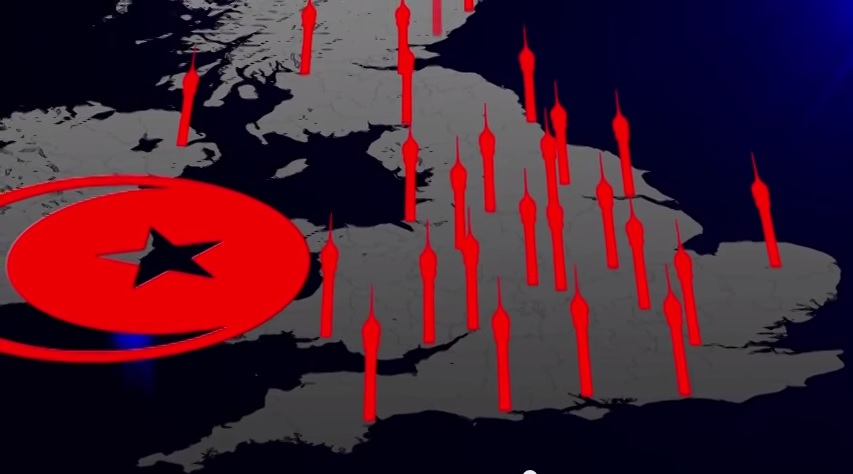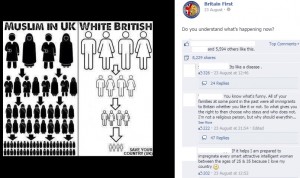
On August 19, Britain First posted a link to a new documentary that features their leader Paul Golding. A short description accompanied the link:
The trailer makes various bold claims about an impending “Islamic conquest” but many are simply recycled anti-Muslim conspiracy theories.
One of main points of contention is the idea of “infiltration” – an infiltration via increased birthrates. To illustrate this point, the trailer demonstrates a rising chart that implies Europe is under a ‘wave’ of Muslim migration. A point reinforced with imagery of migrants upon boats.
No evidence conclusively proves those aboard are Muslim, it merely serves to frame Muslim identity along racial lines, and reinforce the pernicious infiltration theory.
Britain First also repackaged another debunked video titled ‘Muslim Demographics’ and uploaded it to their LiveLeak account.
Yet, the theory behind rising Muslim birthrates pre-dates both Britain First and ‘Europe’s Last Stand’. Prior to 9/11, the concept of Eurabia existed on the peripheries of society. A shifting perception of Muslim migration only took place after 9/11.
By 2005, the myth increased thanks to the release of ‘Eurabia: The Euro-Arab Axis’ by Bat Ye’or. It alleges that European politicians struck a deal with Arab nations to allow for an Islamic takeover in exchange for oil.
The late polemicist and new atheist Christopher Hitchens dabbled in the language of Eurabia. In 2007, Hitchens used the term “Londonistan” when describing Muslim migration in Finsbury Park. To contrast changing demographics, he focused upon the visible religiosity of Muslim women “wearing the veil, and even swathed in the chador or the all-enveloping burka.”
For a piece that focused on extremists, Hitchens reminded his audience that unlike other migrants, all Muslims share a faith that is “not ashamed to speak of conquest and violence”.
In the same article, Hitchens went on to dismiss Islamophobia as a “newly invented and meaningless term.”
A year earlier, he told an audience, “Most of the immigrants to Western Europe, who want to make up this deficit, come at the moment from Muslim countries, and everybody knows that there’s a possible trap door underneath that apparent free gift of cheap labour.”
Islamisation became normalised in other political circles. In 2008, controversial far-right Dutch politician Geert Wilders told a conference:
Norwegian terrorist Anders Behring Breivik used the fear of Islamisation in an attempt to justify murdering 77 people and injuring 242.
In more recent times, the rhetoric and imagery of Islamisation was used by the UK far-right at the 2014 European elections. The British National Party’s (BNP) election video faced censorship but still featured a ‘flood’ of niqabs, halal butchers and minarets changing British identity.
Britain First used their election video to scaremonger about rising Muslim demographics. Both believe that Britain’s traditional “bulldog spirit” is now a whimper. Amid a collapsing BNP vote, Britain First usurped them in Scotland but not in Wales.
Britain First continues to push the Islamisation myth (with a measure of success), a recent Facebook posting warned, “By 2050, Britain will be a majority Muslim nation Did our grandparents die for this?” That image gained over 18,000 ‘likes’ and nearly 15,000 online shares.
Nor are newspapers immune from the alarmist rhetoric around Muslim demographics. In early 2014, several discovered that almost a tenth of babies and under-fives in England and Wales are Muslim. The data originates from the 2011 census, but religion is a voluntary question, which 7 per cent of people refused to answer, and more children aged 0-4 had no religion than those who were recorded as Muslim.
In 2011, Pew noted that despite an expected rise in Muslim populations globally (compared to non-Muslims), it will occur at a slower rate. The research claimed, “From 1990 to 2010, the global Muslim population increased at an average annual rate of 2.2%, compared with the projected rate of 1.5% for the period from 2010 to 2030.”
It also found that a majority of Muslims globally would live in the Asia-Pacific region. Other projections from Pew indicate that birthrates for British Muslims will slightly decline in the next fifteen years.
Channel 4’s FactCheck dismissed the idea that Britain will be a Muslim-majority state in 2050. It concluded that Britain’s Muslim population would not top 10 per cent, let alone 50 per cent in 2050.
If Britain underwent this tectonic shift of faith (or loss of faith), it would not affect the 26 bishops in the House of Lords, or the Queen (or King) acting as the ceremonial head of the Church of England. A point often ignored by certain groups.
A fear of a ‘Muslim takeover’ is more conspiracy than fact. Yet, it seductively ties into racialised fears of a tiny minority “aggressively” displacing the majority, and it drips into various political discussions.

